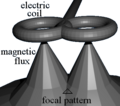Transcranial magnetic stimulation
Transcranial Magnetic Stimulation[edit]

Transcranial Magnetic Stimulation (TMS) is a noninvasive procedure that uses magnetic fields to stimulate nerve cells in the brain. It is primarily used to treat depression and other neurological and psychiatric disorders.
History[edit]
The concept of using magnetic fields to influence brain activity dates back to the 19th century. However, it was not until 1985 that the first TMS device was developed by Anthony Barker and his colleagues in Sheffield, England. Since then, TMS has evolved significantly and is now widely used in both research and clinical settings.
Mechanism of Action[edit]
TMS works by generating a magnetic field that induces an electric current in the brain. This current can modulate neuronal activity, either enhancing or inhibiting it, depending on the frequency and pattern of stimulation. The most common form of TMS is repetitive TMS (rTMS), which involves repeated pulses of magnetic energy.

Clinical Applications[edit]
Depression[edit]
TMS is most commonly used to treat major depressive disorder (MDD), especially in patients who have not responded to traditional treatments such as medication and psychotherapy. The U.S. Food and Drug Administration (FDA) approved TMS for the treatment of depression in 2008.
Other Disorders[edit]
Research is ongoing into the use of TMS for other conditions, including anxiety disorders, schizophrenia, post-traumatic stress disorder (PTSD), and chronic pain.
Procedure[edit]
During a TMS session, a coil is placed against the patient's scalp. The coil generates a magnetic field that passes through the skull and into the brain. The procedure is typically performed in an outpatient setting and does not require anesthesia. A typical session lasts about 30 to 60 minutes, and patients usually undergo a series of sessions over several weeks.

Safety and Side Effects[edit]
TMS is generally considered safe, with few side effects. The most common side effects include headache, scalp discomfort, and tingling sensations. Rarely, TMS can cause seizures, particularly in individuals with a history of epilepsy.
Research and Future Directions[edit]
Ongoing research is exploring the potential of TMS to treat a variety of neurological and psychiatric conditions. Studies are also investigating the use of TMS in combination with other therapies, such as cognitive behavioral therapy (CBT) and pharmacotherapy.

Related Pages[edit]
References[edit]
<references group="" responsive="1"></references>
-
Transcranial magnetic stimulation
-
Neuro-MS device for TMS
-
TMS focal field illustration
-
TMS Butterfly Coil on head
Ad. Transform your life with W8MD's Budget GLP-1 injections from $75


W8MD offers a medical weight loss program to lose weight in Philadelphia. Our physician-supervised medical weight loss provides:
- Weight loss injections in NYC (generic and brand names):
- Zepbound / Mounjaro, Wegovy / Ozempic, Saxenda
- Most insurances accepted or discounted self-pay rates. We will obtain insurance prior authorizations if needed.
- Generic GLP1 weight loss injections from $75 for the starting dose.
- Also offer prescription weight loss medications including Phentermine, Qsymia, Diethylpropion, Contrave etc.
NYC weight loss doctor appointmentsNYC weight loss doctor appointments
Start your NYC weight loss journey today at our NYC medical weight loss and Philadelphia medical weight loss clinics.
- Call 718-946-5500 to lose weight in NYC or for medical weight loss in Philadelphia 215-676-2334.
- Tags:NYC medical weight loss, Philadelphia lose weight Zepbound NYC, Budget GLP1 weight loss injections, Wegovy Philadelphia, Wegovy NYC, Philadelphia medical weight loss, Brookly weight loss and Wegovy NYC
|
WikiMD's Wellness Encyclopedia |
| Let Food Be Thy Medicine Medicine Thy Food - Hippocrates |
Medical Disclaimer: WikiMD is not a substitute for professional medical advice. The information on WikiMD is provided as an information resource only, may be incorrect, outdated or misleading, and is not to be used or relied on for any diagnostic or treatment purposes. Please consult your health care provider before making any healthcare decisions or for guidance about a specific medical condition. WikiMD expressly disclaims responsibility, and shall have no liability, for any damages, loss, injury, or liability whatsoever suffered as a result of your reliance on the information contained in this site. By visiting this site you agree to the foregoing terms and conditions, which may from time to time be changed or supplemented by WikiMD. If you do not agree to the foregoing terms and conditions, you should not enter or use this site. See full disclaimer.
Credits:Most images are courtesy of Wikimedia commons, and templates, categories Wikipedia, licensed under CC BY SA or similar.
Translate this page: - East Asian
中文,
日本,
한국어,
South Asian
हिन्दी,
தமிழ்,
తెలుగు,
Urdu,
ಕನ್ನಡ,
Southeast Asian
Indonesian,
Vietnamese,
Thai,
မြန်မာဘာသာ,
বাংলা
European
español,
Deutsch,
français,
Greek,
português do Brasil,
polski,
română,
русский,
Nederlands,
norsk,
svenska,
suomi,
Italian
Middle Eastern & African
عربى,
Turkish,
Persian,
Hebrew,
Afrikaans,
isiZulu,
Kiswahili,
Other
Bulgarian,
Hungarian,
Czech,
Swedish,
മലയാളം,
मराठी,
ਪੰਜਾਬੀ,
ગુજરાતી,
Portuguese,
Ukrainian



